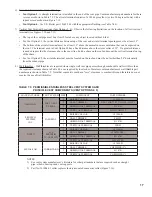
13
2) Maximum Vent and Air Intake Lengths - The maximum length of the vent air intake piping depends upon the vent
option selected and the boiler size. See Table 7.1 or 7.9 for the maximum vent length. In horizontal vent systems, the
lengths shown in Table 7.1 are in addition to the first standard elbow on top of the boiler. For vertical vent systems,
the maximum vertical vent lengths shown in Table 7.9 are in addition to two elbows. If more elbows are desired, the
maximum allowable vent length must be reduced by the amount shown in Table 7.8
for each additional elbow used.
Termination fittings are never counted, although the length of the concentric terminal section, included with the boiler, is
counted.
Example:
A 60/100mm concentric vent system is planned for a horizontally vented FCM120 which has the following components:
80/125 x 60/100mm Reducing Elbow (supplied with the boiler)
5 ft Straight Pipe.
90 elbow
1 ½ ft Straight Pipe
45 Elbow
Uncut Terminal Section (supplied with the boiler)
The Vent Option #1 column in Table 7.1 describes a horizontal direct vent system using 60/100mm concentric vent pipe.
From this column, we see that a FCM120 may have a vent length of up to 18 ft. The 90 degree reducing elbow is not
considered. The length of the terminal section (not including the plastic terminal itself) is approximately 22 1/2” (1.9
ft) installed. From Table 7.8, we see that the equivalent length of the 60/100mm elbow is 4.5 ft and that the equivalent
length of the 45 degree elbow is 4 ft. The total equivalent length of the planned venting system is therefore:
5 ft (Straight ) + 4.5 ft (90 Elbow) + 1.5 ft (Straight ) + 4 ft (45 Elbow) + 1.9 ft (Uncut Terminal Section) = 16.9 ft.
Since Table 7.1 shows a maximum allowable vent length of 18 ft, the planned vent system length is acceptable.
3) Minimum Vent and Air Intake Lengths - Observe the minimum vent lengths shown in tables 7.1 and 7.9.
4) Permitted Terminals for Horizontal Venting:
•
Vent Option 1
- The concentric 60/100mm concentric vent terminal is supplied with the boiler as part of the standard
vent system.
•
Vent Option 2
- The exhaust terminal is U.S. Boiler part 8110701. The air intake fitting is a 90 degree elbow with a
rodent screen supplied by the installer. This elbow is made out of the same material as the rest of the air inlet system
(either galvanized or PVC) and is installed as shown in Figure 7.3
•
Vent Option 3
- Two terminals are permitted:
a. 80/125mm Concentric Vent Terminal (U.S. Boiler part 101494-01).
b. 80/125mm Snorkel Terminal (U.S. Boiler part 101544-01). This terminal allows the vent system to exit the
building close to grade and go up the exterior wall far enough to provide adequate clearance between the terminal
itself and the snow line (see Figure 7.7).
5) Horizontal Vent and Air Intake Terminal Location - Observe the following limitations on the vent terminal location (also
see Figures 7.6a, 7.6b, 7.6c and 7.7). When locating a concentric terminal, observe the limitations outlined below for
“vent terminals”.
• Vent terminals must be at least 1 foot from any door, window, or gravity inlet into the building.
• For twin pipe terminals, maintain the correct clearance and orientation between the vent and air intake terminals.
The vent and air intake terminals must be at the same height and their center lines must be between 12 and 36 inches
apart. Both terminals must be located on the same wall.
• The bottom of all terminals must be at least 12” above the normal snow line. In no case should they be less than 12”
above grade level.
• The bottom of the vent terminal must be at least 7 feet above a public walkway.
• Do not install the vent terminal directly over windows or doors.
• The bottom of the vent terminal must be at least 3 feet above any forced air inlet located within 10 feet.
• A clearance of at least 4 feet horizontally must be maintained between the vent terminal and gas meters, electric
meters, regulators, and relief equipment. Do not install vent terminal over this equipment.
• Do not locate the vent terminal under decks or similar structures.
• Top of vent terminal must be at least 5 feet below eves, soffits, or overhangs. Maximum depth of overhang is 3 ft.
Summary of Contents for FREEDOM
Page 8: ...8 Figure 1 Wall Mounting Hole locations ...
Page 9: ...9 Figure 5 2 Boiler Mounting Hardware ...
Page 11: ...11 Figure 6 1 Boiler Installed In A Confined Space Ventilation Air From Inside ...
Page 42: ...42 FIGURE 7 51 CONDENSATE PIPING ARRANGEMENT ...
Page 55: ...55 Figure 10 1 Wiring Connections Diagram ...
Page 56: ...56 Figure 10 2 Ladder Diagram ...
Page 57: ...57 Figure 10 3 Wiring of Isolation Relay for Control of Two Heating Circulators ...
Page 60: ...60 FCM Series Lighting and Operating Instructions ...
Page 66: ...66 FIGURE 12 2 BASIC MENU TREE ...
Page 75: ...75 ...
Page 77: ...77 ...
Page 79: ...79 ...
Page 80: ...80 ...
Page 81: ...81 ...
Page 83: ...83 150 151 152 153 154 155 ...
Page 84: ...84 156 157 158 159 160 161 ...
Page 85: ...85 162 ...














































